There is a lot of confusion surrounding this issue, mostly because lithium-ion batteries are different from older, nickel-based batteries (which suffered from a nasty memory effect not present in lithium-ion batteries). You’re right, though—charging them incorrectly can decrease their lifespan. Most lithium batteries should last you a few years, but improper care can decrease that lifespan, meaning that your battery will be unable to hold a charge—or unable to hold as big a charge as it used to—quicker. So, to clear things up, here’s how to actually extend your battery’s health as much as possible.
Perform shallow discharges. Instead of discharging to 0% all the time, lithium-ion batteries do best when you discharge them for a little bit, then charge them for a little bit. The table at the right, from Battery University, shows that discharges to 50% are better for your battery’s long-term life than, say, small discharges to 90% or large discharges to 0% (since the 50% discharges provide the best number of cycles-to-usage ratio).
Don’t leave it fully charged. Similarly, lithium-ion batteries don’t need to be charged all the way to 100%. In fact, they’d prefer not to be—so the 40%-80% rule you heard is a good guideline. When possible, keep it in that range to prolong its life as long as you can. And, if you do charge it to 100%, don’t leave it plugged in. This is something most of us do, but it’s another thing that will degrade your battery’s health. If you need to charge it overnight, use something like the Belkin Conserve Socket to stop it from charging after it’s full.
See on lifehacker.com

Speak Your Mind